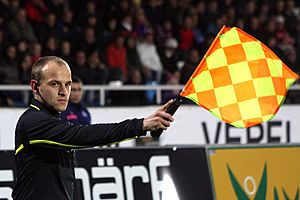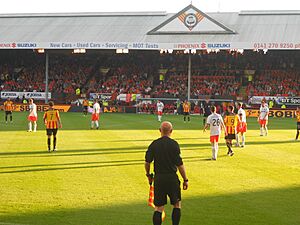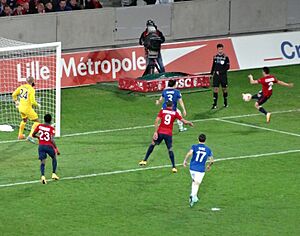Assistant referee (association football) facts for kids

In association football, an assistant referee (once called a linesman) is an official who helps the main referee. They make sure the Laws of the Game are followed during a match. While not strictly required, most organized football games have a referee and at least two assistant referees. Their jobs are explained in Law 6, which is about "The Other Match Officials."
Assistant referees usually watch to see if the ball goes out of play. They also decide which team gets to throw the ball back in. They help with offside calls and tell the referee about fouls they might have missed. These two officials stand on opposite sides of the field, each covering one half.
For bigger games, there's also a fourth official. This person usually handles administrative tasks. For example, they manage player substitutions. The fourth official stays near the teams' benches, called the technical areas.
Rules for competitions explain how to replace officials who can't continue. Often, the fourth official steps in if the referee or an assistant referee gets hurt. The rules also allow for reserve assistant referees. These officials only step in if someone else needs to be replaced.
In very important games, there might be even more assistants. Additional assistant referees stand near the goals. They watch for incidents close to the goal line. Video assistant referees (VARs) watch video replays. They can tell the referee to review decisions that might be wrong.
Remember, the main referee is the boss during the game. The assistants give advice, but the referee can always make the final decision.
Contents
Working Together: The Officiating Team
Law 6 of the Laws of the Game explains how the officials work as a team. They all help to enforce the rules during a game. The referee always has the final say on all decisions. Assistant referees and the fourth official should tell the referee if they saw something more clearly.
In big games, all the officials might wear headsets. This lets them talk to each other easily. It helps them communicate over long distances or when the stadium is very loud.
Having a team of officials means someone can step in if an official can't continue. The specific rules for who replaces whom depend on the competition.
All officials wear uniforms that match the referee's uniform. The fourth official might wear a tracksuit over their uniform if it's cold.
Different Roles of Officials
The Assistant Referee's Job
The Laws of the Game say that "two assistant referees may be appointed." These officials move along the sidelines, also called touchlines. Each one covers their own half of the field.
Assistant referees help the main referee with several things:
- Seeing if the whole ball has gone out of play.
- Deciding which team gets to restart the game.
- Making offside decisions.
- Managing player substitutions if there is no fourth official.
- Spotting fouls or other rule breaks the referee didn't see.
All decisions made by assistant referees are just advice for the referee. Their calls are not final, and the referee can overrule them. The referee might also ask an assistant referee for their opinion on something. Sometimes, assistant referees help with free kicks or penalty kicks. They also help the referee with tasks before and after the game.
Assistant referees carry bright flags. These flags are usually red, yellow, or a mix of colors. They use them to show their decisions to the referee, players, and fans. During the game, each assistant referee covers one touchline and one end of the field. This is part of the diagonal system of control. The more experienced assistant usually stands on the side with the team benches. This helps them oversee substitutions. In higher-level games, the flags might have buttons. The assistant referee can press a button to send a sound to the referee's earpiece. This gets the referee's attention.
Assistant referees used to be called linesmen. In 1996, the name changed. This was to better show their modern role and to be fair to all genders. However, some people still unofficially use the old term.
The Fourth Official's Job
The fourth official helps the referee with many tasks. They can also step in if another official can't continue. This idea of having a backup referee started in 1966. But the International Football Association Board (IFAB) didn't officially create the position until 1991. The fourth official's main job is to always help the referee. Their specific duties are often decided by the referee.
The fourth official usually stands a short distance from the sideline. They are positioned between the two teams' technical areas (benches). Their exact spot isn't set by the Laws of the Game.
Fourth officials generally help the referee with:
- Administrative tasks before, during, and after the game.
- Checking players' equipment.
- Managing substitutions, sometimes using a numbered board or electronic display.
- Showing the extra time added at the end of each half. They use a numbered board or electronic display for this.
- Being the main contact between the officials and other people. This includes stadium managers, security, and ball retrievers.
- Keeping order in the teams' technical areas.
- Spotting fouls or other rule breaks the referee didn't see.
In reality, the fourth official is a very important part of the team. They can watch the field and players and tell the referee about things out of their view. The fourth official also keeps extra records. They help make sure the referee doesn't make big mistakes. For example, they might remind the referee if they are about to caution the wrong player. Or if a player has two cautions and should be sent off.
Sometimes, the fourth official is a less experienced member of the team. In this case, they would usually replace an assistant referee if needed. However, in most high-level games, the fourth official is an experienced referee. So, they would replace the main referee if that person couldn't continue.
Additional Assistant Referee's Job
An additional assistant referee (AAR) is an official who stands behind the goal line. Their job is to help the referee see anything that happens near the penalty area. These officials were tested in games like the 2009–10 UEFA Europa League group stage. They help make sure the Laws of the Game are followed. They tell the referee about incidents they might have missed, especially near the penalty area. They use a wireless communication system to talk to the referee.
Their position also gives them a good view to help the referee with "ghost goal" situations. A ghost goal is when it's unclear if the ball crossed the line. The use of additional assistant referees was approved by the IFAB in July 2012. This happened after experiments in various competitions. They were first used in a domestic match in Scotland in the 2013 Scottish Cup Final.
Video Assistant Referee (VAR)
The video assistant referee (VAR) is an official who watches the game on video. They have assistants too. The VAR uses video footage and talks to the on-field referee through a headset. They review decisions made by the referee. They can advise the referee to look at a decision again if it might be wrong. Using VAR is optional for competitions.
Reserve Assistant Referee
The reserve assistant referee (RAR, also called the reserve official) is an official who acts as a backup. They are there to replace an assistant referee or the fourth official if someone gets hurt or can't continue the game. They don't have other duties unless they are called upon to replace another official. Since July 2023, the RAR can also replace an additional assistant referee. They can also help the referee like other officials.
See also




